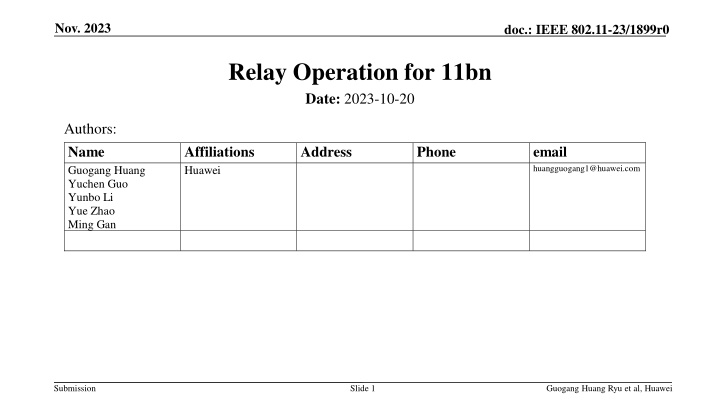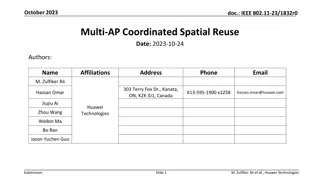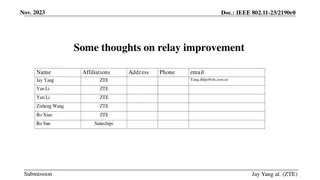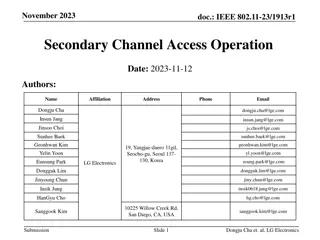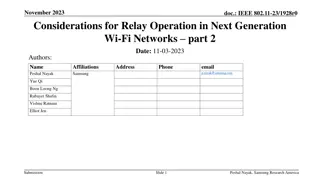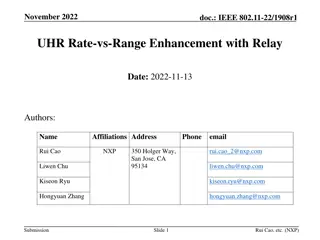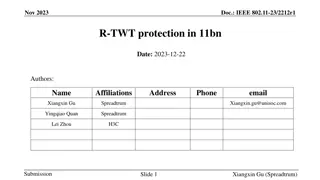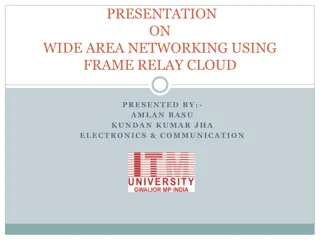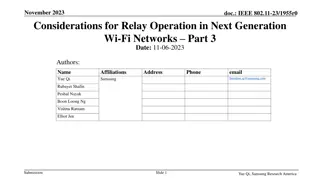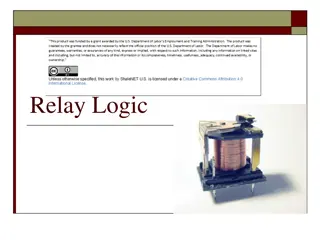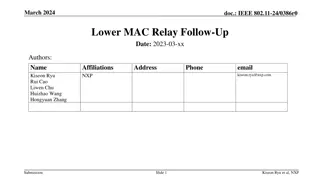IEEE 802.11-23/1899r0 Relay Operation for 11bn - Presentation Summary
In this presentation, the IEEE 802.11-23/1899r0 document discusses relay operations to improve Rate-vs-Range (RvR) performance for UHR. Various potential solutions for implementing a relay protocol in UHR are explored, focusing on enhancing multi-hop channel access delay, end-to-end QoS, and simplifying the relaying protocol. The presentation emphasizes the need for cost-effective designs and discusses the principles and potential solutions for UHR relay design. It introduces the Lower MAC Relay architecture, detailing its functions and involvement in relay operations.
Download Presentation

Please find below an Image/Link to download the presentation.
The content on the website is provided AS IS for your information and personal use only. It may not be sold, licensed, or shared on other websites without obtaining consent from the author.If you encounter any issues during the download, it is possible that the publisher has removed the file from their server.
You are allowed to download the files provided on this website for personal or commercial use, subject to the condition that they are used lawfully. All files are the property of their respective owners.
The content on the website is provided AS IS for your information and personal use only. It may not be sold, licensed, or shared on other websites without obtaining consent from the author.
E N D
Presentation Transcript
Nov. 2023 doc.: IEEE 802.11-23/1899r0 Relay Operation for 11bn Date: 2023-10-20 Authors: Name Guogang Huang Yuchen Guo Yunbo Li Yue Zhao Ming Gan Affiliations Huawei Address Phone email huangguogang1@huawei.com Submission Slide 1 Guogang Huang Ryu et al, Huawei
Nov. 2023 doc.: IEEE 802.11-23/1899r0 Introduction In the document [1], relay is proposed to enhance Rate-vs-Range (RvR) performance for UHR. Some potential solutions/operations to implement a relay protocol in UHR are discussed in [2-4] In this presentation, we share some thoughts on the potential relay architecture and related operations. Submission Slide 2 Guogang Huang et al, Huawei
Nov. 2023 doc.: IEEE 802.11-23/1899r0 Recap UHR Relay Design Principle [2] UHR needs to define relay solutions to Improve multi-hop channel access delay E.g. TXOP sharing enhancement Enhance end-to-end QoS E.g. end-to-end BA/ACK protocol Simplify relaying protocol Reduce relay processing complexity E.g. single user relay, simpler relay signaling, no encryption/decryption, reduced relay packet processing delay Enable cost-effective designs: non-AP STA/uAP can support relaying Much simpler than multi-AP protocol BF support: AP Relay, Relay STA rSTA tSTA dSTA Submission Slide 3 Guogang Huang et al, Huawei
Nov. 2023 doc.: IEEE 802.11-23/1899r0 Recap Potential Solution: Lower MAC Relay (Architecture) [2] Lower MAC Relay provides Hop-by-hop block acknowledgement via relay link and the end-to-end security/SN processing A relay device (rSTA) involves only Lower MAC functions (U) (C) (U) (C) IEEE 802.1X IEEE 802.1X Controlled and Uncontrolled Port Filtering (optional) (M) Controlled and Uncontrolled Port Filtering (optional) (M) RX/TX MSDU Rate Limiting RX/TX MSDU Rate Limiting A-MSDU MSDU Flow - Transmitting A-MSDU MSDU Flow - Transmitting MSDU Flow Receiving MSDU Flow Receiving Aggregation (TX) / De-aggregation (RX) Aggregation (TX) / De-aggregation (RX) Replay Detection Per PN (optional) Replay Detection Per PN (optional) PS Defer Queuing1 (AP MLD Only) PS Defer Queuing1 (AP MLD Only) Upper MAC sublayer: tSTA/dSTA only functions Block Ack Buffering and Reordering per SN Block Ack Buffering and Reordering per SN A-MPDU processing Sequence Number Assignment Sequence Number Assignment MPDU Decryption MPDU Decryption Optional Relay BlockAck Scoreboarding, etc. Note: It is similar to per-link functions in the EHT ML framework. End devices (transmitter STA: tSTA, and destination STA: dSTA) involve both Upper MAC functions Packet Number Assignment Packet Number Assignment Duplicate Detection per SN Duplicate Detection per SN E2E Block Ack Scoreboarding E2E Block Ack Scoreboarding MPDU Encryption MPDU Encryption Null Null Null Null Relay Block Ack Scoreboarding Relay Block Ack Scoreboarding Null MPDU Header + CRC Creation MPDU Header + CRC Creation MPDU Header + CRC Creation Address 1 address filtering Address 1 address filtering Address 1 address filtering lower MAC sublayer: Relay functions MPDU Header + CRC Validation security process MPDU Header + CRC Validation MPDU Header + CRC Validation A-MPDU Aggregation SN generation/reordering A-MPDU Aggregation A-MPDU Aggregation A-MPDU De-aggregation A-MPDU De-aggregation A-MPDU De-aggregation E2E Block Ack Scoreboarding, etc. Lower MAC functions (PHY SAP) (PHY SAP) (PHY SAP) PHY of tSTA PHY of dSTA PHY of rSTA A-MPDU processing Optional Relay BlockAck Scoreboarding, etc. Note: It is similar to MLD functions with upper MAC functions and lower MAC functions in the EHT ML framework. dSTA tSTA rSTA Submission Slide 4 Guogang Huang et al, Huawei
Nov. 2023 doc.: IEEE 802.11-23/1899r0 Relay Architecture (1/2) If the relay device equips with more than one radio, a possible way is to regard the relay as a non- colocated AP affiliated with the AP MLD, as shown in below figure, referred as rAP (i.e. AP 13). The rAP communicates with the AP MLD through AP12 and relay STA (referred as rSTA ). rSTA and rAP are implemented on different channels/bands. Relay MLD with multiple radios Relay function 5GHz rAP (AP13)@ 6GHz 6GHz rSTA Wireless backhaul STA13 Non-AP MLD MLD common MAC STA12 AP12@5 GHz AP MLD AP11@2.4 GHz STA11 Submission Slide 5 Guogang Huang et al, Huawei
Nov. 2023 doc.: IEEE 802.11-23/1899r0 Relay Architecture (2/2) If the relay device equips with only one radio, then the sole radio behaviors as both rSTA and rAP. In this case, AP12, rSTA and rAP are implemented on the same channel. Relay MLD with single radio Relay function rAP rSTA Relay link@ 5 GHz Wireless backhaul Direct link@ 5 GHz MLD common MAC STA12 AP12@5 GHz AP MLD Non-AP MLD AP11@2.4 GHz STA11 Submission Slide 6 Guogang Huang et al, Huawei
Nov. 2023 doc.: IEEE 802.11-23/1899r0 Discovery of rAP The relay MLD indicates it supports the relay operation and other transmission capabilities when initiating the association with the AP MLD. Once the association is established, the AP MLD can follow the current Multi-link operation to advertise the existence of a rAP as an affiliated AP through the RNR element and the Basic Multi-link element. Considering the rAP may not transmit the Beacon /Probe Response frame, it should be invisible for the EHT non-AP MLD. Hence, Use a new TBTT Info Field Type to advertise the info on the rAP in the RNR element. Define a Relay Profile subelement for the Basic Multi-link element to carry the info on the rAP. To distinguish the rAP from other affiliated AP, a Relay Flag bit may be introduced. Submission Slide 7 Guogang Huang et al, Huawei
Nov. 2023 doc.: IEEE 802.11-23/1899r0 Selection of non-AP MLD If a non-AP MLD has a good link quality with the rAP, the AP MLD can recommend the UHR non- AP MLD to add a relay link with the rAP by sending Link Reconfiguration Notify frame. Then the UHR non-AP MLD can request to add a relay link with the rAP by exchanging Link Reconfiguration Request/Response frame. In order to identify whether the UHR non-AP MLD is located near the rAP, the AP MLD can request the non-AP MLD to do the Beacon Request measurement. Since the rAP doesn t transmit the Beacon/Probe Response frame, we need to define a new Measurement Mode. E.g. NDP Request + NDPA + NDP. Submission Slide 8 Guogang Huang et al, Huawei
Nov. 2023 doc.: IEEE 802.11-23/1899r0 Summary In this contribution, a potential architecture for the relay operation in UHR is discussed. Reuse the current Multi-link operation by viewing the relay as a reduced affiliated AP We also discussed The channel measurement between the rAP and the non-AP MLD Define a new measurement mode for the Beacon Request measurement. Submission Slide 9 Guogang Huang et al, Huawei
Nov. 2023 doc.: IEEE 802.11-23/1899r0 References [1] IEEE 802.11-22/1908r1 UHR rate-vs-range enhancement with relay [2] IEEE 802.11-23/1175r0 UHR Relay Follow-up [3] IEEE 802.11-23/1138r1 Features to consider for efficient Relay operation [4] IEEE 802.11-23/1139r0 Relay transmission in UHR Submission Slide 10 Guogang Huang et al, Huawei
